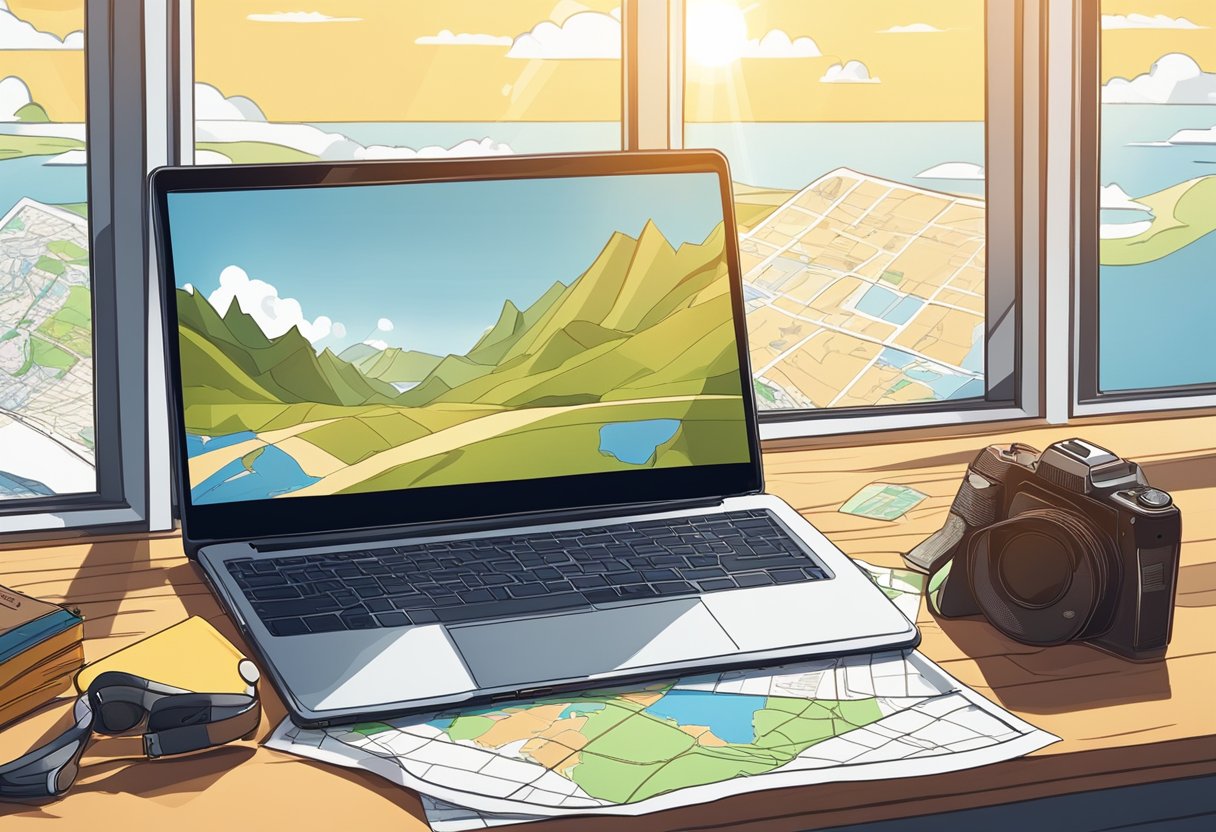

- Directory
- Recent
-
Featured
-
Featured
- Recent
-
- Programs
- Digital Nomad
- Side Gigs
- Resources
Select Page
10 people find this post amazing!

Travel blogging has surged in popularity, becoming much more than a platform to share personal stories; it is now a viable means to a professional and potentially lucrative career. Establishing a travel blog involves several crucial steps, starting with defining a unique brand that resonates with a targeted audience. To build a loyal following, a blogger must pinpoint their niche within the vast travel industry, which could range from budget backpacking to luxury escapades or culture-focused itineraries.
Equally important is the creation of compelling content that not only entertains but also provides value to the reader. This may include detailed guides, personal anecdotes, or professional reviews, all well-crafted to captivate an audience. Moreover, mastering the technical aspects of blogging, understanding and implementing search engine optimization (SEO), and effectively leveraging social media are integral to expanding readership. A successful travel blogger must be adept at these skills to grow their visibility online and sustain their blog.
For those aiming to turn their passion into profit, monetizing the blog through various strategies such as affiliate marketing, partnerships, and sponsored content becomes essential. Accompanied by a robust business plan, a travel blogger can navigate the complexities of turning their blog into a profitable business. As the blog evolves, ongoing evaluation and adaptation remain key to long-term success.
Embarking on the journey of travel blogging begins with several foundational steps. First, an aspiring blogger must choose a blog name that is both memorable and reflective of their brand. This name is not just a label, but the first impression and a concise summary of what the blog is about.
Once the name is decided, securing a domain name that aligns with the blog’s title is crucial. This is the unique web address people will use to find the blog online. It’s important to select a domain that’s straightforward, easy to recall, and has a strong connection to the travel niche.
Next comes choosing a hosting service. Reliable hosting ensures that the blog remains accessible around the clock. The service stores all website content and makes it available to visitors online. Consider hosting services well known for their uptime and support, as they are an integral part to any blog’s success.
WordPress is highly recommended as a content management system. It’s user-friendly, versatile, and offers numerous themes and plugins to help customize and enhance the blog. Its robust community and myriad of tutorials make it a favorable platform for travel bloggers.
Identifying a niche within travel blogging can help set a blog apart. Whether it’s luxury travel, budget adventures, or culinary journeys, focusing on a specific area can attract a devoted audience.
Finally, while building an online presence, it’s important to put effort into creating a strong brand. This includes a consistent voice, recognizable design, and a content strategy that resonates with the target audience.
By carefully considering each of these elements, one can confidently take the first steps into the world of travel blogging.
Choosing the Right Name: The name of a travel blog is its first impression and a crucial aspect of its brand identity. It should be unique, memorable, and give an idea of what the blog is about without limiting future content. One should avoid overly specific names that might not be relevant as the blog evolves.
Designing a Logo: A logo serves as the visual cornerstone of a travel blog’s branding. It should be distinctive and recognizable, working harmoniously with the blog’s overall theme.
Consistent Theme and Design: The design and theme of the blog should reflect the essence of its content. Utilizing consistent fonts and color schemes throughout the site strengthens the brand and aids in visual recognition. A well-designed blog increases credibility and user engagement.
Photographic Style: Photographs are a powerful tool in travel blogging. They should capture the spirit of the blog’s content and contribute to the brand. Using a consistent editing style or subject focus contributes to a coherent visual identity.
Creating a Brand Message: The blog’s messaging should communicate its core values and purpose effectively. This message can not only attract one’s ideal audience but also keep them engaged.
Design Elements:
Remember that branding goes beyond mere aesthetics; it encapsulates the travel blog’s mission, voice, and promise to its readers.
Creating compelling content as a travel blogger involves a detailed content strategy and the ability to tell stories visually. The content should not only provide valuable information but also engage and inspire the audience to explore the world.
An effective content strategy begins with planning. Travel bloggers should identify their niche and tailor their content toward the interests and motivations of their target audience. They need to focus on topics like unique travel experiences, cultural insights, and local recommendations, which are pivotal for travel-related content.
In travel blogging, impactful visual storytelling can transport readers to distant lands. High-quality photography and well-edited videos play a major role in captivating an audience.
Utilizing these content creation strategies allows travel bloggers to produce content that not only informs but also inspires and incites wanderlust in their readers.
When entering the world of travel blogging, an adept content creator harnesses the power of social media to amplify their presence. They start by understanding the unique advantages each platform offers. For instance, Instagram is a treasure trove for visually-oriented content where engaging images of destinations can foster a robust social following.
The savvy blogger should strategize their content to match the nuances of each platform. Here’s a practical approach they could take:
Creating a content calendar and using scheduling tools also helps them stay consistent. By engaging actively and posting regularly, travel bloggers cast a wider net to entice and maintain their audience’s attention. With a thoughtful approach to social media, they enhance their visibility and create more pathways to their travel content.
To thrive in travel blogging, one must grasp the essentials of Search Engine Optimization (SEO). SEO is the practice of optimizing content to rank higher in search results, making a blog more visible to potential readers.
The first step involves keyword research. Identifying the right keywords and phrases allows bloggers to create content that answers the questions potential visitors are asking. A balanced use of relevant keywords in titles, headings, and throughout the content can lead to significant traffic increases.
Using tools like Google Analytics is vital for tracking performance. It helps bloggers understand their audience and measure the impact of their SEO strategies. Metrics like page views, bounce rate, and average session duration provide insights, enabling them to make informed adjustments.
Here is a simple strategy to start:
Remember that SEO is not just about search engines but also about providing a great user experience. A blog that is informative, engaging, and easy to navigate is more likely to retain visitors. Moreover, it’s key to stay updated with SEO best practices as algorithms change frequently.
Travel bloggers must ensure their sites are mobile-friendly and load quickly, as these factors also affect search rankings. Site structure, meta descriptions, and alt tags for images should not be overlooked in the context of SEO.
By implementing these SEO techniques, bloggers can enhance their online presence and set their travel blogs up for success.
A successful travel blog can become a significant revenue stream. To monetize it effectively, one must understand the mechanics of generating income through affiliate marketing and establishing fruitful collaborations and partnerships.
Travel bloggers can earn money by promoting products or services and earning a commission for each sale or action taken by their visitors. They typically join affiliate marketing programs where they can select from a variety of products to promote on their blog. Effective affiliate marketing requires a balance between solid content and strategic placement of affiliate links ensuring that the promotions are relevant to the audience. Transparency is also key, as readers appreciate honesty about affiliate links.
Best practices for affiliate marketing include:
Collaborations and partnerships can be lucrative for travel bloggers. They can monetize their travel blog by working directly with brands and tourism boards to promote destinations, services, or products. A key aspect of successful partnerships is leveraging the blog’s traffic to create exposure for the brand, which in return, provides compensation to the blogger.
Types of collaborations include:
When seeking partnerships, bloggers should:
When starting a travel blog, understanding the technical components is crucial. One begins by selecting a domain name—the unique address of the site on the internet (e.g., www.yourtravelblog.com).
Upon choosing a domain, one must secure it through domain registration, which is often coupled with a hosting plan. Web hosting services provide the technology and support necessary for the website to be viewed online.
A popular choice for hosting a travel blog is WordPress, a versatile content management system (CMS). To set up a WordPress site, one should:
Travel bloggers can also enhance their website’s functionality using WordPress plugins. These are installable extensions that add new features or improve existing ones. Some useful plugins for travel blogs might include:
To install plugins on a WordPress site:
A well-structured blog hinges on the seamless integration of these technical elements. One’s choice of domain, web hosting, WordPress themes, and plugins collectively shape the blog’s identity and user experience.
To enhance engagement and foster growth within a travel blog, one should implement strategies that captivate and retain visitors. They must ensure that the content appeals to their audience by being both informative and entertaining. Regular posting of high-quality content is essential, as it encourages readers to return and share their discoveries with others, thereby increasing traffic.
The use of social media platforms is imperative; they serve as a tool to promote content and engage directly with followers. One can gain a loyal audience through consistent interaction, such as responding to comments or questions, which helps in building a community around the blog. Social media can also be utilized to share sneak peeks of upcoming content or to involve readers in the content creation process, suggesting a collaborative effort.
Leveraging search engine optimization (SEO) techniques will help improve the blog’s visibility. Through targeted keywords relevant to travel blogging, the site will attract more organic visitors.
Furthermore, one should consider the following tactics:
By focusing on these core aspects, one can expect a gradual but steady increase in their audience, ensuring the travel blog’s success and longevity.
When embarking on travel blogging, choosing a niche or specialization is crucial. Niches help bloggers to stand out and attract a dedicated audience. Here’s a concise guide to some popular travel niches:
Bloggers should consider their passion and expertise when selecting a niche. A well-chosen niche not only informs content strategy but also helps in building a loyalty within a specific community of travelers.
When venturing into travel blogging, a robust business plan is crucial for long-term success. This plan lays out a blueprint that details how one will turn their passion into a profit-generating venture.
Firstly, they outline their business strategy. This includes their unique value proposition—what sets their blog apart from the rest. They then set specific, measurable goals, such as reaching a full-time income within a certain timeframe.
Market Analysis:
Financial Planning:
To ensure sustainability, they create a long-term strategy with milestones. This could involve diversifying income sources to guard against market fluctuations.
Operational Plan:
Lastly, they continuously review and adjust their plan to stay aligned with their goals and adapt to changing market conditions. This ongoing process supports their path toward success in the competitive world of travel blogging.
Travel blogging offers a unique blend of flexibility and freedom, allowing individuals to delve into a lifestyle that isn’t confined to the traditional 9-to-5 structure. For those aspiring to become professional travel bloggers, achieving success requires a commitment to producing quality content, engaging with readers, and continuously learning about digital marketing and SEO tactics.
Travel bloggers enjoy the ability to shape their professional path while immersing themselves in diverse cultures and experiences. Their work not only enriches their own lives but also inspires and informs others. The journey to becoming a professional travel blogger may be challenging, but it is also gratifying for those with a passion for travel and storytelling.
This section addresses common inquiries about starting and running a successful travel blog, focusing on practical tips for beginners and strategies for growth and monetization.
For beginners, starting a travel blog involves choosing a compelling name, setting up a hosting account, selecting a blogging platform like WordPress, and creating content that resonates with their target audience. It’s essential to understand the basics of SEO and social media marketing to increase visibility. More details on starting a travel blog can be found from this Forbes Advisor guide.
One can begin blogging with minimal investment by using free blogging platforms and utilizing social media to gain traction. They should focus on creating high-quality content and leveraging free tools for SEO and online marketing. Over time, investing in a domain name and professional hosting can help scale the blog. Insight into low-cost blogging can be gained from Nomadic Matt.
Travel bloggers can generate income through affiliate marketing, selling their own products or services, sponsored content, and advertising revenue. Building a strong brand and audience can also open opportunities for paid trips and partnerships. Goats on the Road provides a closer look into making a living from travel blogging.
Growing an audience involves consistently producing valuable content, engaging with readers through comments and social media, and leveraging SEO techniques. Collaborating with other bloggers and guest posting can also help reach a broader audience.
Successful content strategies include focusing on a niche, leveraging storytelling, providing unique insights, and creating comprehensive guides that resonate with specific interests or destinations. Using visuals and maintaining an authentic voice also enhances reader engagement.
Travel bloggers establish collaborations by showcasing a professional media kit, demonstrating their reach and engagement, and networking at industry events. They pitch unique collaboration ideas that align with the brand’s values and audience interests. It’s also key to maintain transparency about such partnerships with the audience.
Table of Contents

Achieve Your Goals Now!
